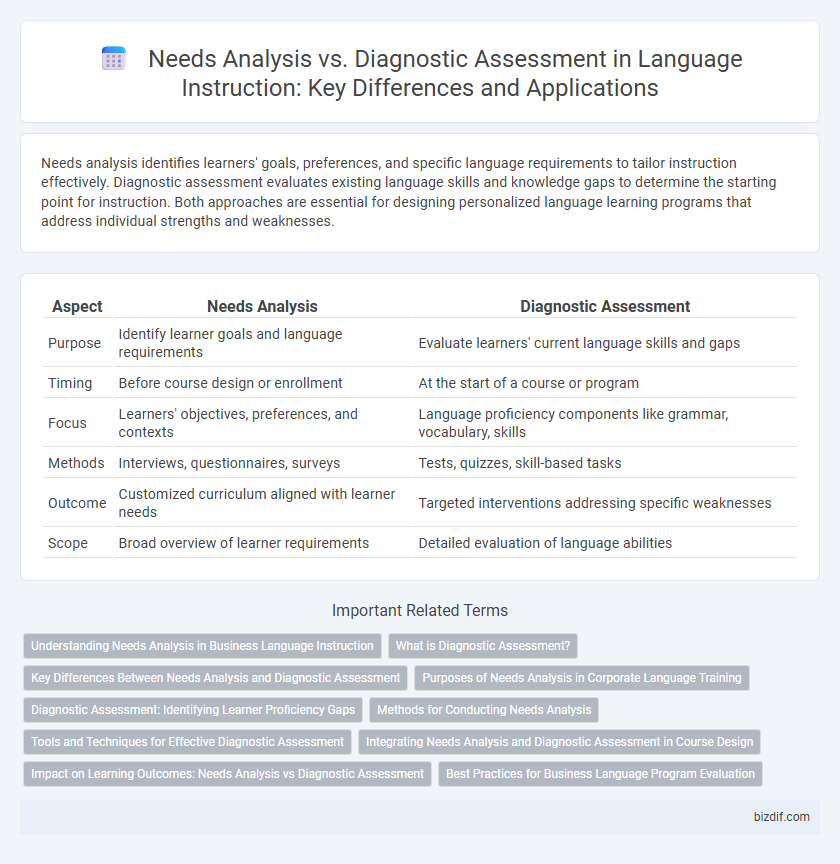Needs analysis identifies learners' goals, preferences, and specific language requirements to tailor instruction effectively. Diagnostic assessment evaluates existing language skills and knowledge gaps to determine the starting point for instruction. Both approaches are essential for designing personalized language learning programs that address individual strengths and weaknesses.
Table of Comparison
| Aspect | Needs Analysis | Diagnostic Assessment |
|---|---|---|
| Purpose | Identify learner goals and language requirements | Evaluate learners' current language skills and gaps |
| Timing | Before course design or enrollment | At the start of a course or program |
| Focus | Learners' objectives, preferences, and contexts | Language proficiency components like grammar, vocabulary, skills |
| Methods | Interviews, questionnaires, surveys | Tests, quizzes, skill-based tasks |
| Outcome | Customized curriculum aligned with learner needs | Targeted interventions addressing specific weaknesses |
| Scope | Broad overview of learner requirements | Detailed evaluation of language abilities |
Understanding Needs Analysis in Business Language Instruction
Needs analysis in business language instruction identifies specific linguistic skills required for professional contexts by evaluating learners' goals, job roles, and communication tasks. This analysis informs curriculum design by prioritizing relevant vocabulary, industry-specific terminology, and functional language tailored to workplace demands. Unlike diagnostic assessment, which measures existing language proficiency, needs analysis drives targeted learning outcomes to enhance job performance and business communication effectiveness.
What is Diagnostic Assessment?
Diagnostic assessment identifies learners' existing language skills and gaps before instruction begins, enabling tailored teaching strategies. It evaluates strengths and weaknesses in grammar, vocabulary, pronunciation, and comprehension to inform curriculum design. Unlike needs analysis, which explores learners' goals and contexts, diagnostic assessment focuses specifically on current language proficiency and areas requiring improvement.
Key Differences Between Needs Analysis and Diagnostic Assessment
Needs analysis identifies learners' goals, preferences, and motivations to tailor language instruction effectively. Diagnostic assessment evaluates existing language skills, strengths, and weaknesses to determine learners' proficiency levels and address gaps. While needs analysis focuses on future learning objectives, diagnostic assessment emphasizes current knowledge and skill deficits for targeted intervention.
Purposes of Needs Analysis in Corporate Language Training
Needs analysis in corporate language training identifies specific language skills required for job performance, ensuring training aligns with organizational goals. It evaluates employee language proficiency, communication challenges, and contextual demands to tailor curriculum effectively. This process enhances training relevance, facilitating improved workplace communication and productivity.
Diagnostic Assessment: Identifying Learner Proficiency Gaps
Diagnostic assessment precisely identifies learners' proficiency gaps by evaluating existing language skills and knowledge before instruction begins. This targeted evaluation helps instructors tailor lesson plans to address specific weaknesses, ensuring efficient language acquisition. Unlike needs analysis, diagnostic assessments focus on pinpointing current competencies rather than general learner goals or preferences.
Methods for Conducting Needs Analysis
Methods for conducting needs analysis in language instruction include surveys, interviews, observations, and competency tests that gather data on learners' goals, language proficiency, and learning preferences. These methods enable educators to tailor curriculum design by identifying the specific linguistic skills and content relevant to the target audience. In contrast, diagnostic assessment primarily evaluates learners' existing language abilities to pinpoint strengths and weaknesses without directly informing curricular needs.
Tools and Techniques for Effective Diagnostic Assessment
Diagnostic assessment employs a variety of tools and techniques such as language proficiency tests, learner interviews, and error analysis to identify specific strengths and weaknesses in language skills. Utilizing computer-adaptive testing and portfolio assessments enhances the precision of diagnostic results by providing detailed insights into learner performance across different language domains. Effective diagnostic assessment tools enable tailored instruction plans by pinpointing exact areas for improvement, thereby optimizing language learning outcomes.
Integrating Needs Analysis and Diagnostic Assessment in Course Design
Integrating needs analysis and diagnostic assessment in course design ensures tailored language instruction by identifying learners' goals, preferences, and existing skill gaps. Needs analysis gathers specific learner requirements through surveys and interviews, while diagnostic assessment evaluates language proficiency and cognitive abilities. Combining both methods enables the creation of targeted curricula that adapt instructional strategies to optimize learner outcomes and engagement.
Impact on Learning Outcomes: Needs Analysis vs Diagnostic Assessment
Needs analysis identifies learners' specific language goals and gaps, enabling tailored instruction that directly targets relevant skills, thus improving motivation and engagement. Diagnostic assessment evaluates existing language proficiency and difficulties, allowing precise identification of strengths and weaknesses to inform remedial strategies. Together, these methods optimize learning outcomes by aligning teaching approaches with individual learner profiles and targeted language development.
Best Practices for Business Language Program Evaluation
Needs analysis identifies learners' specific language skills and professional contexts to tailor business language programs effectively. Diagnostic assessment evaluates existing language competencies, enabling targeted interventions and progress tracking. Integrating both approaches ensures precise program customization and measurable outcomes in business language training.
Needs analysis vs Diagnostic assessment Infographic

 bizdif.com
bizdif.com